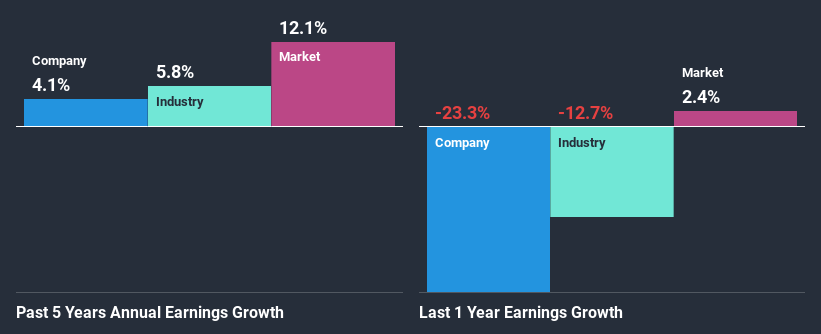Employers Holdings, Inc. (NYSE:EIG) Stock Is Going Strong But Fundamentals Look Uncertain: What Lies Ahead ?
Employers Holdings (NYSE:EIG) has had a great run on the share market with its stock up by a significant 20% over the last month. However, we decided to pay attention to the company's fundamentals which don't appear to give a clear sign about the company's financial health. Specifically, we decided to study Employers Holdings' ROE in this article.
Return on equity or ROE is an important factor to be considered by a shareholder because it tells them how effectively their capital is being reinvested. In other words, it is a profitability ratio which measures the rate of return on the capital provided by the company's shareholders.
See our latest analysis for Employers Holdings
How Do You Calculate Return On Equity?
ROE can be calculated by using the formula:
Return on Equity = Net Profit (from continuing operations) ÷ Shareholders' Equity
So, based on the above formula, the ROE for Employers Holdings is:
9.9% = US$120m ÷ US$1.2b (Based on the trailing twelve months to December 2020).
The 'return' is the yearly profit. Another way to think of that is that for every $1 worth of equity, the company was able to earn $0.10 in profit.
What Has ROE Got To Do With Earnings Growth?
Thus far, we have learned that ROE measures how efficiently a company is generating its profits. We now need to evaluate how much profit the company reinvests or "retains" for future growth which then gives us an idea about the growth potential of the company. Assuming all else is equal, companies that have both a higher return on equity and higher profit retention are usually the ones that have a higher growth rate when compared to companies that don't have the same features.
A Side By Side comparison of Employers Holdings' Earnings Growth And 9.9% ROE
When you first look at it, Employers Holdings' ROE doesn't look that attractive. Yet, a closer study shows that the company's ROE is similar to the industry average of 9.0%. On the other hand, Employers Holdings reported a fairly low 4.1% net income growth over the past five years. Bear in mind, the company's ROE is not very high . Hence, this does provide some context to low earnings growth seen by the company.
As a next step, we compared Employers Holdings' net income growth with the industry and were disappointed to see that the company's growth is lower than the industry average growth of 5.8% in the same period.
Earnings growth is an important metric to consider when valuing a stock. What investors need to determine next is if the expected earnings growth, or the lack of it, is already built into the share price. This then helps them determine if the stock is placed for a bright or bleak future. If you're wondering about Employers Holdings''s valuation, check out this gauge of its price-to-earnings ratio, as compared to its industry.
Is Employers Holdings Efficiently Re-investing Its Profits?
Employers Holdings has a low three-year median payout ratio of 19% (meaning, the company keeps the remaining 81% of profits) which means that the company is retaining more of its earnings. However, the low earnings growth number doesn't reflect this fact. So there could be some other explanation in that regard. For instance, the company's business may be deteriorating.
In addition, Employers Holdings has been paying dividends over a period of at least ten years suggesting that keeping up dividend payments is way more important to the management even if it comes at the cost of business growth. Our latest analyst data shows that the future payout ratio of the company is expected to rise to 56% over the next three years. Therefore, the expected rise in the payout ratio explains why the company's ROE is expected to decline to 4.8% over the same period.
Summary
On the whole, we feel that the performance shown by Employers Holdings can be open to many interpretations. While the company does have a high rate of profit retention, its low rate of return is probably hampering its earnings growth. That being so, according to the latest industry analyst forecasts, the company's earnings are expected to shrink in the future. Are these analysts expectations based on the broad expectations for the industry, or on the company's fundamentals? Click here to be taken to our analyst's forecasts page for the company.
This article by Simply Wall St is general in nature. It does not constitute a recommendation to buy or sell any stock, and does not take account of your objectives, or your financial situation. We aim to bring you long-term focused analysis driven by fundamental data. Note that our analysis may not factor in the latest price-sensitive company announcements or qualitative material. Simply Wall St has no position in any stocks mentioned.
Have feedback on this article? Concerned about the content? Get in touch with us directly. Alternatively, email editorial-team (at) simplywallst.com.

